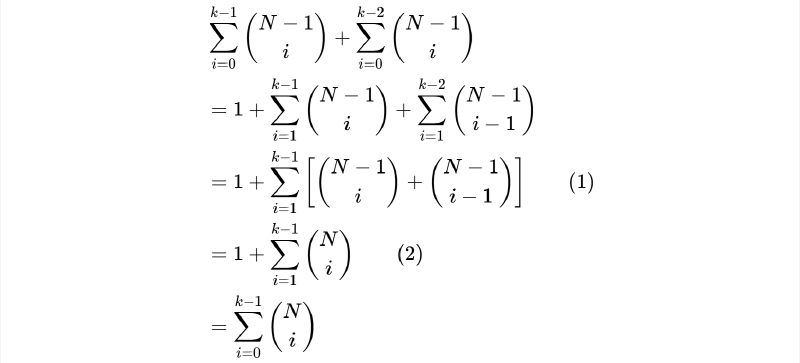The Explanation of Function B
\(B(N, k)\) denotes the maximum number of dichotomies on \(N\) points, with break point \(k\). For example, \(B(1000, 4)\) denotes the number of dichotomies that a 2-dimensional perceptron can make on 1000 data points.
Note: A 2-dimensional perceptron has a break point of 4, which means a 2-dimensional perceptron cannot offer all dichotomies on 4 points.
The Recursive Function B
For a dataset with \(N\) data points, the total number of possible dichotomies is \(2^N\), because each data point has two possible classifications. In this case, the growth rate of the number of dichotomies is an exponential function of \(N\). However, due to the existence of a break point, the actual growth rate becomes a polynomial function of \(N\), with the degree of the polynomial related to \(k\).
Reasoning Process: We divide the \(B(N,k)\) dichotomies into two categories based on the following rule: if we ignore the last data point (the \(N\)-th data point), are the dichotomies of the first \(N-1\) data points unique?
- Dichotomies that are unique go into Class A.
- Dichotomies that are repeated go into Class B.
For example, suppose a dataset has three data points and an algorithm generates four classification methods: 1,0,1, 1,0,0, 0,0,1, 0,1,1. Ignoring the last data point, there are two repeated patterns (1,0) and two unique patterns (0,0 and 0,1).
By definition, Classes A and B are disjoint, and their union is the original set (because each pattern is either unique or repeated).
Let \(\alpha\) be the number of dichotomies in Class A.
Since each dichotomy in Class B is repeated exactly twice (the \(N\)-th data point has two possibilities), let the number of dichotomies in B be \(2\beta\).
Thus:
Also, \(\alpha + \beta\) represents the total number of unique dichotomies for the first \(N-1\) data points, so:
$$ \alpha + \beta \le B(N-1,k) $$The break point of B is \(k-1\). This is because if there were \(k-1\) columns in B that cover all possible binary patterns, then adding the \(N\)-th data point would create \(k\) columns that cover all possible binary patterns.
For example, if \(k=4\), meaning that among all dichotomies, any 4 columns cannot form all binary patterns, and suppose B contains 3 columns:
0 0 0
0 0 1
0 1 0
0 1 1
1 0 0
1 0 1
1 1 0
1 1 1
After adding one more data point, we can find 4 columns that cover all possible binary patterns:
0 0 0 0
0 0 1 0
0 1 0 0
0 1 1 0
1 0 0 0
1 0 1 0
1 1 0 0
1 1 1 0
0 0 0 1
0 0 1 1
0 1 0 1
0 1 1 1
1 0 0 1
1 0 1 1
1 1 0 1
1 1 1 1
Thus, B cannot have \(k-1\) columns covering all binary patterns, meaning the break point is at most \(k-1\).
Therefore:
$$ \beta \le B(N-1, k-1) $$Combining the above, we obtain:
$$ B(N,k) = \alpha + 2\beta \le B(N-1,k) + B(N-1, k-1) $$The Implementation of Recursive Function B
Show/Hide the code
| |
The Table of Function B
Show/Hide the code
| |
k=1 k=2 k=3 k=4 k=5 k=6 k=7 k=8 k=9 k=10
N=1 1 2 2 2 2 2 2 2 2 2
N=2 1 3 4 4 4 4 4 4 4 4
N=3 1 4 7 8 8 8 8 8 8 8
N=4 1 5 11 15 16 16 16 16 16 16
N=5 1 6 16 26 31 32 32 32 32 32
N=6 1 7 22 42 57 63 64 64 64 64
N=7 1 8 29 64 99 120 127 128 128 128
N=8 1 9 37 93 163 219 247 255 256 256
N=9 1 10 46 130 256 382 466 502 511 512
N=10 1 11 56 176 386 638 848 968 1013 1023
A Theorem
$$ B(N,k) \le \sum_{i=0}^{k-1}{\binom{N}{i}} $$Show/Hide the code
| |
Goal:
$$ \sum_{i=0}^{k-1}{\binom{N}{i}}=\sum_{i=0}^{k-1}{\binom{N-1}{i}}+\sum_{i=0}^{k-2}{\binom{N-1}{i}} $$Steps:
$$ \begin{align} &\sum_{i=0}^{k-1}{\binom{N-1}{i}}+\sum_{i=0}^{k-2}{\binom{N-1}{i}} \nonumber \\ &=1 + \sum_{i=1}^{k-1}{\binom{N-1}{i}}+\sum_{i=1}^{k-2}{\binom{N-1}{i-1}} \nonumber \\ &=1 + \sum_{i=1}^{k-1}{\left[\binom{N-1}{i}+\binom{N-1}{i-1}\right]} \qquad\text{(1)} \nonumber \\ &=1 + \sum_{i=1}^{k-1}{\binom{N}{i}} \qquad\text{(2)} \nonumber \\ &=\sum_{i=0}^{k-1}{\binom{N}{i}} \nonumber \end{align} $$Note: An intuitive way to understand how (1) becomes to (2) is to consider the essence of the combination formula. The term \(\binom{N}{i}\) represents the number of ways to choose \(i\) people from a total of \(N\). There are two mutually exclusive scenarios for any particular person: either they are chosen, or they are not.
If the person is not chosen, then we need to select all \(i\) people from the remaining \(N-1\), giving \(\binom{N-1}{i}\) combinations. If the person is chosen, we have already selected one, so we only need to choose the remaining \(i-1\) people from the other \(N-1\), resulting in \(\binom{N-1}{i-1}\) combinations. Together, these two cases account for all possible selections.
